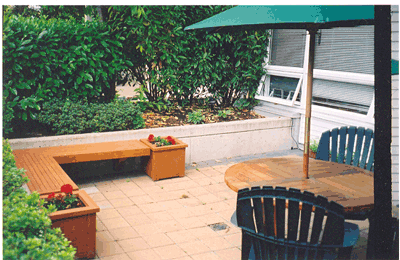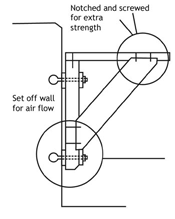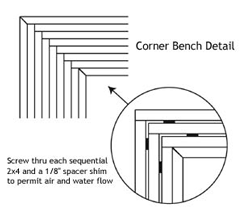Built In Patio Benches For Urban Spaces
Urban condo patios benefit from beautiful built-in benches too

Imagine this concrete and paver stone patio without the warmth of these wood benches.
Kind of bare and cold, don't you think?
So I turned this previously bare space into a focal point with these attractive benches.
They were built right into the corner of the concrete flower beds.
With a few common-sense building techniques, they were ready to shed water, stay drier, and last a lot longer.
Detailed Diagrams Showing What Was Involved
When you are attaching any wood structure to a concrete wall, the key point is to create airflow at all moisture contact points. Concrete is porous and wicks water. So you want to keep the wood away from it a bit and dry.

This particular design will withstand heavy rain and humidity for years to come because the bench support brackets never touch the concrete.
In this case, the location was wet and rainy Vancouver, BC. I know it can be beautiful and dry for months at a time during the summer, but the winters are WET.
Here was a solution I used, and the benches are still in great shape over nine years later.
Building Gaps Between Deck Bench Boards

Corner benches can use this building technique very well.
It's a herringbone technique that visually pleases and eliminates 45-degree miter cuts that always expand and shrink irregularly over time.
Notice how each board (2x2s)in the bench seat is separated by a 1/8" shim rather than simply nailing each board together.
This building technique should be used where ever possible.
It is imperative that you create air space around each board - as much as possible; otherwise, once the rain comes, all the water will sit on each board and saturate them. Then the rotting process begins.
The result is a set of built-in patio benches that are ready for what Mother Nature can throw at them.
But this applies not just to the wet Pacific Northwest but also to humid areas in the east as well. Places like Georgia, North Carolina, even New York State can have a lot of wet, humid weather for much of the year.
Keep this in mind.
Home > Deck Benches & Extras > Built in Patio Benches


























